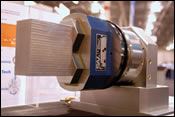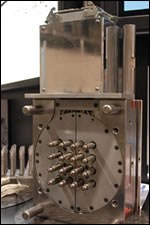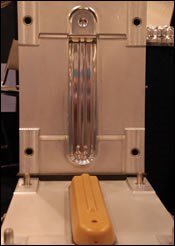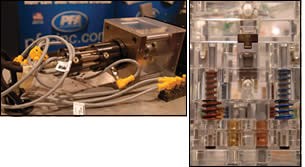MoldMaking Expo 2008 Post-Show Report Change Is Good
Once again, the industry rolls with the punches as MME showcases the latest and greatest in products, equipment and technologies designed to manufacture molds in the quickest, most efficient ways possible.
This year’s MoldMaking Expo brought together just about 2,400 industry professionals to learn, network and view first-hand a variety of moldmaking-specific product, equipment and technology offerings from leading suppliers. Overall, the mood was optimistic as most exhibitors and attendees believe the industry is starting to see a shift toward more work returning to North America. The conference, exhibits and networking opportunities prevalent at this year’s show reflected a real interest and willingness from today’s mold manufacturers to change.
While the past decade has seen a number of shops closing their doors, the strong have survived and will continue to do so. If the right strategic plan is put in place—both on the technology and business side—fine-tuning a niche and evolving from moldmaking to mold manufacturing will strengthen your company and ensure future success. There was no better place to gather information on how to incorporate new value-added services to stand out from the competition than on the show floor and in the seminars at MoldMaking Expo. The following are industry trends straight from Detroit.
Mold-Specific Solutions to Everyday Challenges
CAD/CAM
Automating the design portion of the mold manufacturing process was hot on the show floor. Software manufacturers and providers are eliminating repetitive steps that can and should be automated. Bill Genc, president of Clear Cut Solutions Inc., points out that there is no reason why and end user should be programming the roughing and semi-finishing routines of electrodes, cores or cavities manually.
Additional CAD/CAM themes included CAD/CAM integration and reducing cycling times. Prevalent upgrades and enhancements included NC program optimization, flexible hybrid environments that allow design in both 2-D and 3-D, new and enhanced cutter paths, improved memory management, and universal post processing to format G-code for virtually any machine tool.
Machining/Cutting Tools
Machine tools now have the ability to multi-task—mold manufacturers want to do more than one process on one machine. In addition, hard milling, micro-machining, remote machining and five-axis machining also were seen on the show floor. All of these methods offer reduced cycle times and high speeds.
Cutting tool offerings also focused on speed. New insert geometries facilitate milling at very high feedrates. More cutters for hard mills were seen at the show; and coatings for cutters are extending tool life, allowing harder materials to be machined, and offering more protection from chip wear. Improved surface finishes also reduce post-mold work. A new collet chuck—specially developed for high-performance machining—is resistant to vibration and stable.
Materials
On the materials end, those featured on the show floor offered good machinability throughout the thickness of the plate, consistent hardness through the plate and more cost-efficient material. Douglas Zeug, Mold Material Specialist for ThyssenKrupp Materials NA/Copper and Brass Sales Division, noted that one of the leading auto makers is looking to use aluminum for production injection tools. “Aluminum is easier to machine versus steel and has four to five times more thermal conductivity,” Zeug notes. “This auto maker has experienced faster cycle times and lower tooling costs due to their conversion from steel to aluminum. This is a trend that could be used by the domestic moldmakers to keep the tool building in this country because of lower cost tools and lower cost parts.”
Process Optimization
Mold manufacturers—always on the lookout for methods to optimize the mold build process—found what they were looking for on the shop floor, whether it was an alliance between companies to offer something brand new, or the latest systems and components.
Workholding/Automation
System 3R USA, Inc. and the Hermann Schmidt Co. have joined forces to automate grinding methodology, which has remained unchanged for more than 20 years. According to Hermann Schmidt President Peter Schmidt, there is a need in the industry for the squaring up of work pieces. The two companies worked closely together to develop SquareTech-a method that can achieve machined tolerances measured in millionths of an inch and within thousandths of a degree.
"The magnetic ability to hold a part comes from Hermann Schmidt, and that works in conjunction with a high accuracy index from System 3R," Schmidt explains. "These applications must work together." This system can either be manually manipulated and/or automated for fast turnaround of parts and the potential for lights-out operation.
Hot Runner
The hot runner market continues to answer the industry’s demand for reducing overall costs, leadtimes and mold uptime. Chris Carls, Engineering Manager at Incoe, says that along with these trends, processability of the end product must be kept in mind. “It is necessary to provide a reliable customized solution in a minimal amount of time that is also maintenance-friendly due to the various hazards that exist in the polymer processing sector,” Carls states. To that end, the company showed its “unitized” hot runner system that comes to the mold builder as a completely assembled, pre-wired, pre-plumbed (hydraulic or pneumatic) and tested unit that is ready to drop into the mold. Outside of some potential gate area contouring, it is ready to go into production—reducing the integration time necessary at the moldmaker’s locations. Additionally, because it is pretested, it also provides a guarantee of functionality with it.
Components
Manufacturers and suppliers in this sector continue to offer today’s mold manufacturer more standardized, modular components designed to trim leadtimes and save money—keys to remaining competitive. And, mold manufacturers are getting much more involved with front-end part design and spec’ing out the components they want their customers to use.
Al Hickok, Midwest Technical Sales Engineer, Progressive Components, adds that there were many conversations about global supply (mostly from molders and OEMs) and the importance of using specs when building in Asia. The company’s conference session was amongst the best attended at the show because attendees were looking for options to compete with, Hickok maintains. “Collapsible Cores is the type of product that is of interest to the moldmaker, the molder and the OEM because it positively affects design, quality, cycle times, price and more,” he explains. “Not many threaded parts are made with Collapsible Cores and if our customers can find a way to offer something different it might give them an edge over the competition.”
Mark Scanlan, Vice President and General Manager of PFA, was pleasantly surprised the company’s Kor-lok side-action systems—geared toward molders—were such a hit with moldmakers. This supports the trend of moldmakers adding presses to their shop floors and offering more value to their customers.
Value Added Services/Front-End Design Collaboration
Today’s times dictate that moldmakers must take an active role in their customers’ quest for better quality parts. To that end, several trends in value-added services and design collaboration were noted at this year’s MoldMaking Expo.
Booth personnel at RJG listened to a lot of requests for designing a process for the molding machine prior to cutting steel for the mold. This also was apparent at Beaumont Technologies, Inc. “A common knowledge of plastic flow fundamentals and mold/part design strategies needs to be gained and accepted within all groups involved in the collaboration,” notes David Hoffman, Beaumont’s Global Director, Technical Sales and Marketing. “This will help everyone be on the same page when discussing such items as to where the part should be gated, for example. We have always asked our customers to get us involved early in the design stage.
Opportunities and More
Whether attempting to keep up with the latest technology, network with peers, or look at a specific piece of equipment or technology, attendees at MoldMaking Expo left the show armed with business strategies and technical know-how to get the job done as efficiently as possible without sacrificing quality. One attendee noted that, “The best part of the show was to introduce ourselves to other shops/vendors to create some partnerships and some outsourcing alliances.”
The editors of MoldMaking Technology magazine would like to thank all of you—attendees, readers, exhibitors, speakers and editorial advisory board members—for your continued support and feedback on this year’s expo and conference.
Related Content
The Role of Social Media in Manufacturing
Charles Daniels CFO of Wepco Plastics shares insights on the role of social media in manufacturing, how to improve the “business” side of a small mold shop and continually developing culture.
Read MoreTop 10 Topics to Cover During an ISO 9001 Manufacturing Audit
Take a look at this practical hands-on approach to conducting a quality audit.
Read MoreTackling a Mold Designer Shortage
Survey findings reveal a shortage of skilled mold designers and engineers in the moldmaking community, calling for intervention through educational programs and exploration of training alternatives while seeking input from those who have addressed the issue successfully.
Read MoreMMT Chats: Solving Schedule and Capacity Challenges With ERP
For this MMT Chat, my guests hail from Omega Tool of Menomonee Falls, Wisconsin, who share their journey with using enterprise resource planning (ERP)—and their people—to solve their schedule and capacity load monitoring challenges.
Read MoreRead Next
How to Use Continuing Education to Remain Competitive in Moldmaking
Continued training helps moldmakers make tooling decisions and properly use the latest cutting tool to efficiently machine high-quality molds.
Read MoreAre You a Moldmaker Considering 3D Printing? Consider the 3D Printing Workshop at NPE2024
Presentations will cover 3D printing for mold tooling, material innovation, product development, bridge production and full-scale, high-volume additive manufacturing.
Read More
























